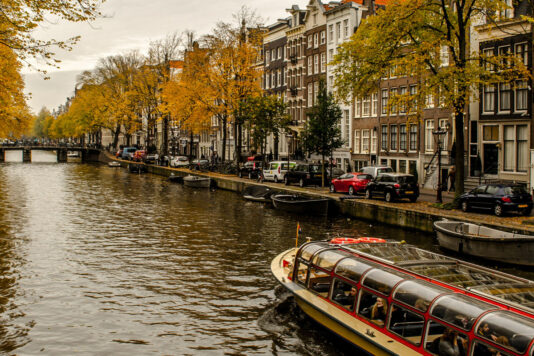November 7, 2023
For our Powering Travel podcast series, Andreas Weissenborn, Vice President of Research and Advocacy at Destinations International, sat down with Expedia Group’s Brandon Ehrhardt, Vice President of B2B Marketing and Andy van der Feltz, Global Senior Director of Business Development to talk about the multiple ways destination marketing organizations have an impact on the tourism industry.
This Q&A is an edited transcript from the podcast “Destination organizations: Making travel possible” where they discussed the latest industry trends, how destination marketing organizations address sustainable tourism, and more.
Brandon Ehrhardt: This week we’re talking about entities at the local level that are making travel possible, destination marketing organizations (DMOs). From marketing attractions to supporting travel providers, the work of a destination organization is vast.
Andy Van der Feltz: I’ve spent a couple of decades working with DMOs in various parts of the world, and for the last seven years with Expedia Group Media Solutions, working closely with DMOs.
BE: Our guest today is Andreas Weissenborn of Destinations International, a global association that helps destination organizations positively impact local communities. His podcast, Architects of Destination Advocacy, is the podcast for professionals in the tourism sector, and it features stories focused on tackling the biggest issues in the industry.
Andreas, can you talk about the structure of destination organizations and how they differ?
Andreas Weissenborn: It’s an entity that is responsible for a community’s brand and promoting it, managing it, and stewarding it. That can be traditional, in the U.S. what we call 501(c)(6) nonprofit for a community, but they can also be a parks department. Really, it’s any entity that brings attention to a community as a brand. The byproducts of this are not only tourism, but also economic development, community vitality, and so on.
You can add responsibilities to that. Let’s say your community has a large conference center. They have the added responsibility of selling what we call convention sales or business events. We’re still talking about a community brand and pushing it out there to get people to pay attention to that brand.
BE: Destination marketing organizations can do a lot to drive and enable travel. Talk about some of the most successful ways a DMO can promote travel.
AW: I’ll use an analogy that’s very similar to a gardener. I acquired a plot of land and quickly realized that if I do nothing, stuff still grows. But the downside of that is the stuff I don’t want to grow still grows. I do think tourism as a byproduct is very similar to that. What a destination organization does is really help synergize and synthesize sales, marketing and promotion of the community, and help bolster it to various suppliers and other channels.
One of the most prominent assets a DMO owns is its website, its brand. If we’re thinking about going to a community, let’s check out its community’s brand. You see this across every type of medium now, it can be a podcast, video, or digital experience, which make it the cornerstone, or what I would call the steward, of that brand for everyone to pay attention to. And when you garner attention, that’s how you acquire tourism from it.
AVDF: I’ve noticed a lot has changed in the world of DMOs, globally, since 2005 or 2006. Then, it was very much about destination management or promotion marketing pushing your brand. But now, curation of content is what’s happening. What are your thoughts about the evolution from the necessity of a website to the necessity to create content on a broader platform?
AW: Let’s dig into a little bit of philosophy. You all understand the link between clean water and health. You understand that to be educated you need teachers. You understand to get to your jobs you need roads and bridges. That’s what we call common goods, or crown goods in the U.K. — things that we deem necessary for society to benefit ourselves, essentially a community shared value.
What I think has changed is communities are starting to understand these common goods. The same thing is true of a brand. When you do not invest in it, whether that’s website marketing, management, or staffing, you fall behind.
Here’s what’s really changed since the pandemic. The No. 1 currency in the world is not gas, it’s not gold, it’s not oil, it’s talent acquisition. We’re in a talent war, here. The pandemic accelerated this trend of no longer having to live where you were. So, from the perspective of destination organization or a community, they now can compete again at this world stage for the greatest currency in world, talent.
I think what communities are starting to recognize is asking, how do we get that attention? It starts with having a brand. The way to invest in a brand is we need a destination organization that represents the community. I think that’s been the fundamental shift, and I would say it’s been on this pathway since 9/11. And like everything, the pandemic accelerated it in a timeline that we’ve never seen before in human history. That’s really what I think the next evolution is, destination organizations being in that pantheon of other common goods, or community shared value.
BE: I want to ask about overtourism, a term that was coined five or six years ago. Who do you feel is responsible for overtourism and what are some ways a destination marketing organization can help support sustainable tourism?
AW: We don’t really believe in the term overtourism. What we believe in is a failure in destination management. One of the problems is that the term overtourism instantly weaponizes or penalizes tourists, and that’s not something you want.
Tourism, for so many communities around the world, is not only a viable investment, but it’s one of the few things communities can invest in that doesn’t cause you to have to tax the resident, which is political suicide. I think we have to move away from the term overtourism, but we also have to understand that management will have an active role in guiding that conversation. If you find yourself in a situation where management has not been the best and people see tourism in a negative sense, that is a role for a destination organization to step in and educate the community on how viable tourism and tourists are to a community’s vitality.
BE: When you look at the global space, the North American space, which DMOs have a good funding model?
AW: I have a lot of favorite destination organizations that I think are doing the job and are sort of unnoticed. It’s easy to point out these super large budget destination organizations that do a great job. But I always like to point out the average operating budget for our membership is under $3 million.
A lot of these smaller destination organizations, for example, Champaign-Urbana, Indiana, is a small operation that’s involved in every single decision as part of the community, as part of a solution. To me, that’s what we call community shared value.
AVDF: I think anyone in travel needs their thoughts heard about sustainability. There is talk about tourism quotas — what do you think about this?
AW: It’s an interesting concept. The destination organization has a role to play and manage that. I think that’s something you’re seeing more and more — we call it tourism etiquette.
AVDF: I think Iceland has done something very similar where they put it on the visitor to be responsible in terms of how they treat the environment that they’re in.
If we look at the total number of people around the world that will travel, we see the middle classes in emerging economies are growing rapidly. What I’m also seeing, perhaps with the more mature DMOs, is chasing high-value guests. The interpretation is fewer people staying longer but spending more. If you’re going to have everybody fighting over what they perceive as a high-value guest who, in your opinion, is going to continue to want to have the lower- or mid-value guest?
AW: I’m not an economist, so it’s hard to answer that aspect of it, but if you are high- to low-value guests, you’re still chasing the same thing, which is experience.
What I think will occur is, if everyone’s going to be chasing that experience as part of it, this leaves room for destination organizations to put their values out there to garner that attention. It may not equate to high-dollar investment, but I do believe it will reoccur as an experience investment. I don’t think any destination organizations say, “I’m targeting just these tiered travelers.” Everyone’s trying to attract an experience and how can we provide the best experience regardless of where you are socioeconomically?
AVDF: I agree with that. However, it does come at some point to the economic impact of the city or region. It will be interesting to watch as it continues to develop around the world.
Now, in terms of utilization of data, from a destination organization’s perspective it has changed. What would you say are the biggest changes and the type of data that DMOs are looking for today?
AW: We firmly live in what I call the golden era of data acquisition. When I started my career, it’s not that we were rudimentary, it wasn’t like it was the Dark Ages, but in comparison to everything that’s accessible now through geolocation data to impact data, to consumer spend data, it is incredible. What I would say though is the data is worthless without any sense of a story behind it. And we’ve seen through the pandemic how much our society has shifted from a logical society to an illogical one. I don’t mean that as a negative sense. I mean that as the opposite of logic, which is emotion. We make decisions based on emotions and story first, and then we find the logic, the data to back it up.
Even though you might have a cornucopia of data now, if your first articulation is data first and ROI first, you’re always going to lose the argument. And I think that’s really something destination organizations leaned into. I like to call it left brain data versus right brain data. Your left brain is sequential, linear, math. We’ve leaned so far left that we’ve forgotten to incorporate what it means for a sense of belonging to our community, the right brain metric story — emotion. We have so much data, there’s now the added responsibility of how you articulate it. I hope destination organizations use the data to articulate story and emotion first. I’m not saying to get away from data on ROI, but this is a one, two punch. Your first punch is your story, your emotion, and then you back it up with the ROI and data.
BE: Let’s talk about “set jetting,” traveling to a destination because you saw it on TV and wanted to experience it. What role does a DMO play in bringing films or TV shows to a city, or publicizing that a show was filmed there?
AW: Destination organizations have asked themselves; how do we rebuild in terms of departments and positions? And the one that I have seen repeatedly now is the investment in film and music-based commissions. Meaning a department solely dedicated to getting a film shot in their community.
One of the biggest and most prominent in the world right now is the state of Georgia and Atlanta. Like the House of the Mouse has moved from Florida up to Georgia for all things Disney, Star Wars, and that type of stuff. There’s a destination organization at the core of that who has a film commission, whose role is to help book those films. And of course, tax assets and things like that are part of it. I do expect in the next five to 10 years you’re going to see more destination organizations announcing a film commission or sports commission department for exactly that asset.
BE: When we think about destination travel, and I’m going to use “White Lotus” as an example, people see this amazing destination and they look it up while they’re watching the show and thinking about traveling there. One of the most popular TV shows, at least in the U.S., “The Wire,” was shot in Baltimore, Maryland. Comparing the settings of “The Wire” to “White Lotus,” they’re starkly different, but I know there is travel associated with both. Depending on the show, does this change the DMO’s approach and how they publicize it?
AW: During my time at Visit Baltimore, and it’s not just “The Wire” but also “Homicide” and “We Own This City,” and we these call flashpoints, where your attention is instantly drawn to your community, and it’s not always for the right reasons.
I think at the core of it is that the destination organization has to lean into authenticity. What you see destination organizations do, like Visit Baltimore, is they leaned into what authenticity means as part of them because not everyone has the benefit of a “White Lotus” show.
AVF: We work closely with advocacy and do so from a Media Solutions point of view. There are so many trends that are happening in the world right now, is there one key trend to keep an eye on in destination management?
AW: One of the biggest challenges is engagement and relevancy. You’re finally starting to see destination organizations enter the foray of advocacy and engagement. So, the trend that I’m seeing is destination organizations are either learning how to hire lobbyists or get involved politically, trying to get more involved than grassroots advocacy. I think that’s one of the most prominent trends.
You can name other travel trends, but related to destination organizations, I really think you’re starting to see this pivot and investment, advocacy, and grassroots engagement. That’s what I think are the cornerstone investments, particularly through the pandemic, when destination organizations were one of the last to get funded when everything hit the fans. That really showed that we still had a long way to go to articulate why we are important and why we should be funded. And you’re starting to see destination organizations start to say, “OK, we can’t be the last at the table anymore. We’ve really got to find ways to bolster our advocacy community engagement so that not only are we thought of first, but now we can actually help set the table.”




